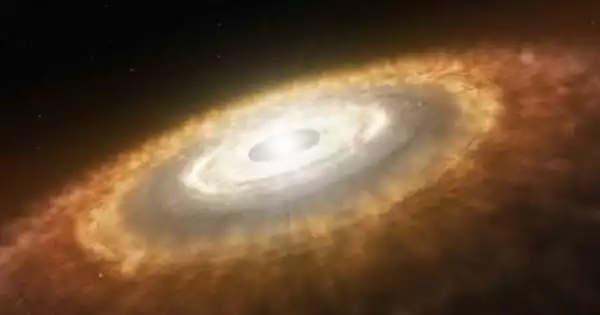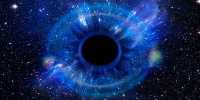A team of researchers discovered evidence of a giant impact in the nearby HD 17255 star system, in which an Earth-sized terrestrial planet and a smaller impactor likely collided at least 200,000 years ago, removing a portion of one planet’s atmosphere.
Growing pains are common in young planetary systems as infant bodies collide and fuse to form progressively larger planets. The Earth and moon are thought to be the products of this type of massive impact in our own solar system. Astronomers believe that such collisions should be common in early systems, but they have been difficult to observe in the presence of other stars.
Astronomers at MIT, the National University of Ireland at Galway, Cambridge University, and other institutions have discovered evidence of a massive impact in a nearby star system, only 95 light years from Earth. The star, known as HD 172555, is about 23 million years old, and scientists believe its dust contains traces of a recent collision.
The MIT-led team discovered new evidence of a massive impact around the star. They determined that the collision occurred at least 200,000 years ago, at speeds of 10 kilometers per second, or more than 22,000 miles per hour, between a roughly Earth-sized terrestrial planet and a smaller impactor.
This is the first time we’ve seen a stripped protoplanetary atmosphere in a giant impact. Everyone is interested in seeing a massive impact because we expect them to be common, but we don’t have evidence for it in many systems. We now have a better understanding of these dynamics.
Tajana Schneiderman
They discovered gas, indicating that such a high-speed impact likely blew away a portion of the larger planet’s atmosphere – a dramatic event that would explain the observed gas and dust around the star. The findings, published today in Nature, are the first of their kind.
“This is the first time we’ve seen a stripped protoplanetary atmosphere in a giant impact,” says lead author Tajana Schneiderman, a graduate student in MIT’s Department of Earth, Atmospheric, and Planetary Sciences. “Everyone is interested in seeing a massive impact because we expect them to be common, but we don’t have evidence for it in many systems. We now have a better understanding of these dynamics.”
A clear signal
Because of the unusual composition of its dust, the star HD 172555 has piqued the interest of astronomers. Recent observations have revealed that the star’s dust contains a large amount of unusual minerals, in grains much finer than astronomers would expect for a typical stellar debris disk.
“Because of these two factors,” Schneiderman explains, “HD 172555 has been thought to be this strange system.”
Her colleagues and she speculated on what the gas might reveal about the system’s impact history. They examined data collected by ALMA, the Atacama Large Millimeter Array in Chile, which consists of 66 radio telescopes whose spacing can be adjusted to increase or decrease image resolution. The researchers combed through data from the ALMA public archive for signs of carbon monoxide near nearby stars.
“When people want to study gas in debris disks, carbon monoxide is usually the brightest and thus the easiest to find,” Schneiderman explains. “As a result, we revisited the carbon monoxide data for HD 172555 because it was an intriguing system.”

In the aftermath
The team was able to detect carbon monoxide around the star after a careful reanalysis. When they calculated its abundance, they discovered that it accounted for 20% of the carbon monoxide found in Venus’ atmosphere. They also noticed that a large amount of gas was circling the star, surprisingly close to it, at about 10 astronomical units, or 10 times the distance between the Earth and the sun.
“The presence of carbon monoxide at this close range necessitates some explanation,” Schneiderman says.
This is due to the fact that carbon monoxide is typically susceptible to photodissociation, a process in which photons from a star break down and destroy the molecule. So close to a star, there would typically be very little carbon monoxide. As a result, the team tested various hypotheses to explain the gas’s abundant, close-up appearance.
They quickly ruled out the possibility that the gas arose from the debris of a newly formed star, as well as the possibility that the gas was produced by a nearby belt of icy asteroids. They also considered the possibility that the gas was emitted by a swarm of icy comets streaking in from a distant asteroid belt, similar to our own Kuiper belt. However, the data did not fit this scenario either. The team’s final thought was that the gas was a byproduct of a massive impact.
“Of all the scenarios,” Schneiderman says, “it’s the only one that can explain all of the data’s features.” “We expect giant impacts in systems of this age, and we expect giant impacts to be quite common. The timescales are correct, the age is correct, and the morphological and compositional constraints are correct. In this context, the only plausible process that could produce carbon monoxide in this system is a massive impact.”
The team believes the gas was released by a massive impact at least 200,000 years ago, which was recent enough that the star did not have time to completely destroy the gas. Based on the abundance of the gas, the impact was most likely massive, involving two proto-planets roughly the size of the Earth. The force of the impact was so powerful that it most likely blew off a portion of one planet’s atmosphere, resulting in the gas observed by the team.
“There is now the possibility of future work outside of this system,” Schneiderman says. “We show that finding carbon monoxide in a location and morphology consistent with a giant impact opens up a new avenue for looking for giant impacts and understanding how debris behaves in the aftermath.”















